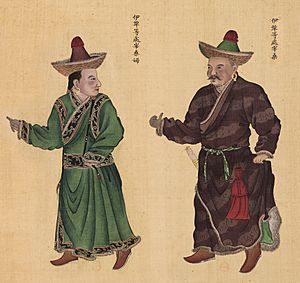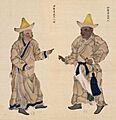Dzungar people facts for kids
| ᠵᠡᠭᠦᠨᠭᠠᠷ | |
|---|---|
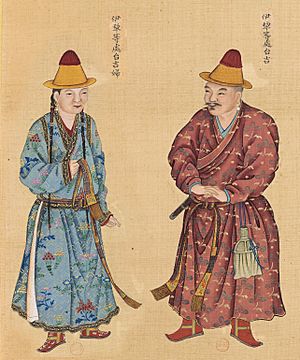
Mongol Prince (Taiji) from Ili and other regions and his wife, Huang Qing Zhigong Tu, 1769.
|
|
| Total population | |
| 658,372-668,372 | |
| Regions with significant populations | |
| 250,000 (2013 estimate) | |
| 205,000 (2010 census) | |
| 183,372 (Kalmyk) | |
| 12,000 (Kalmyk) | |
| 325 (Kalmyk) | |
| 1,500 (Kalmyk) | |
| Languages | |
| Oirat, Chagatai | |
| Religion | |
| Tibetan Buddhism | |
| Dzungar people | |||||||||||
|---|---|---|---|---|---|---|---|---|---|---|---|
| Chinese name | |||||||||||
| Traditional Chinese | 準噶爾 | ||||||||||
| Simplified Chinese | 准噶尔 | ||||||||||
|
|||||||||||
| Mongolian name | |||||||||||
| Mongolian Cyrillic | Зүүнгар, Mongolian pronunciation: [tsuːŋˈɢɑr] | ||||||||||
| Mongolian script | ᠵᠡᠭᠦᠨᠭᠠᠷ | ||||||||||
| Kazakh name | |||||||||||
| Kazakh | Жоңғар [ʑwʊɴˈʁɑɾ] Joñğar جوڭعار |
||||||||||
The Dzungar people (also called Zunghar or Junggar) were a group of Oirat Mongol tribes. Their name comes from Mongolian words meaning 'left hand'. They were important in the 17th and 18th centuries. During this time, they created and ruled the Dzungar Khanate. They were also known as the Eleuths or Ööled. Today, many people with Dzungar roots live in Mongolia, China, Russia, and Kazakhstan.
Contents
Who Were the Dzungars?
The Dzungars were a group of several Oirat tribes. They came together in the early 1600s. Their main goal was to fight for control over Mongolian lands. They fought against other Mongol groups and later the Manchu (who ruled China).
This group became powerful in an area called the Junggar Basin. This region is located between the Altai Mountains and the Ili Valley. At first, the group included the Oöled, Dörbet Oirat, and Khoid tribes. Later, parts of the Khoshut and Torghut tribes joined them. This brought together most of the West Mongolian tribes.
According to old stories, the Oöled and Dörbet tribes came from the Naimans. The Naimans were a Mongol group from the time of Genghis Khan. The Oöled and Dörbet tribes shared a family name called Choros. The terms Zuun gar ("left hand") and Baruun gar ("right hand") were used for their military and government groups. In the 1600s, the Dzungar Olot people and Choros became the main ruling families.
Dzungar History and Decline
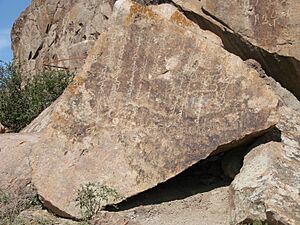
The Dzungars lived in a large area. It stretched from the Great Wall of China to eastern Kazakhstan. It also went from northern Kyrgyzstan to southern Siberia. This area is mostly in what is now Xinjiang. They were the last major nomadic empire to challenge China. This happened from the early 1600s to the mid-1700s.
During this time, the Dzungars were very advanced. They were among the first in Central Asia to make their own gunpowder weapons. They also had a mixed economy, combining farming and herding. They developed mining and manufacturing. The Dzungars even created laws to encourage the use of the Oirat language across their empire.
The Qing Dynasty and the Dzungars
After many battles, the Dzungars were defeated by the Manchu-led Qing dynasty in the late 1750s. The Qing Emperor, Qianlong, wanted to break up the Dzungar state. He planned to divide them into four tribes. However, a Dzungar leader named Amursana wanted to unite his people. He rebelled against the Qing plan.
Because of this, Emperor Qianlong decided to completely remove the Dzungar people and their name. Qing forces, including Manchu and Khalkha (Eastern) Mongols, fought against the Dzungars. Many Dzungar people lost their lives or were forced to move. Some were enslaved.
Historians say that a large number of Dzungars died during this period. Many were killed by the Qing army. Others died from diseases like smallpox. Some fled to Russia or joined Kazakh tribes. This led to a huge reduction in the Dzungar population. It was a devastating time for the Dzungar people and their state.
Changes in the Region
Before the Qing conquest, some Uyghur groups had already joined the Qing. These Uyghurs had been under Dzungar rule and did not like it. They helped the Qing forces fight the Dzungars. Uyghur leaders were given important titles by the Qing. They helped the Qing communicate with other Muslims in the region. The Qing told these Muslims that they only wanted to defeat the Dzungars, not harm the Muslim people.
After the Dzungars were defeated, their lands in Dzungaria became empty. The Qing dynasty then encouraged millions of people to move there. These new settlers included Han Chinese, Hui, Uyghurs, Xibe, and Kazakhs. Today, the area that was once Dzungar territory is mostly inhabited by Kazakhs.
The Qing also created new cities in Dzungaria, like Ürümqi and Yining. The Qing dynasty was responsible for uniting the region now known as Xinjiang. They also changed who lived there. The defeat of the Dzungars, who followed Vajrayana Buddhism, led to Islam becoming more important in southern Xinjiang. The Qing allowed or even supported Muslim culture and identity.
China's New Identity
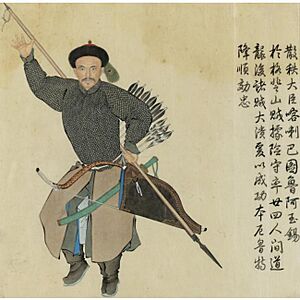
The Qianlong Emperor saw the conquest of the Dzungars as adding new land to "China." He believed that China was a country with many different ethnic groups, not just the Han Chinese. He said that both Han and non-Han peoples were part of "China," including the new lands taken from the Dzungars.
The Qing leaders used phrases like "interior and exterior as one family." This meant they wanted to unite all the different peoples under Qing rule. They saw groups like the Mongols and Tibetans as part of one big family with the Han Chinese.
After the Qing victory, some Dzungars, known as Oolods, were resettled in different areas. Some formed administrative groups in places like Hulun Buir. Others moved to Khovd Province in Mongolia. The Dzungars who remained in Xinjiang were also renamed Oolods. They continued to be an important part of the Mongol groups in the region.
Images for kids
-
A commoner from Ili and other regions, with his wife. Huang Qing Zhigong Tu, 1769


